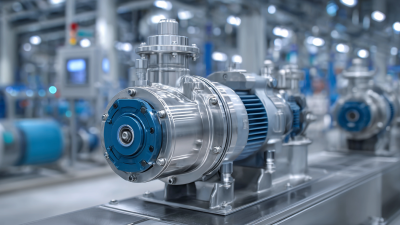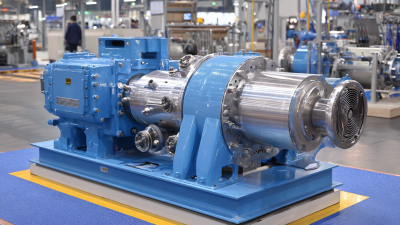Sealless Pumps for a Safer and Greener World


In the evolving landscape of modern industrial applications, the adoption of sealless magnetic drive pumps has emerged as a pivotal advancement, offering significant operational advantages. According to a report by Research and Markets, the global magnetic drive pump market is projected to reach $2.5 billion by 2025, driven by increasing demand for efficiency and reliability in fluid transfer systems. Sealless magnetic drive pumps operate without traditional mechanical seals, which minimizes leakage risks and reduces maintenance costs. This technology not only enhances safety by preventing hazardous material exposure but also contributes to environmental sustainability by reducing product loss. As industries strive for higher performance standards and compliance with stringent regulations, the integration of sealless magnetic drive pumps represents a strategic investment, promising optimizations in process efficiency and cost-effectiveness.

Sealless magnetic drive pumps have revolutionized various industrial applications by enhancing efficiency and reliability. These pumps operate without traditional mechanical seals, which significantly reduces the risk of leaks and maintenance requirements. This unique design enables them to handle hazardous and corrosive fluids with minimal environmental impact, making them an ideal choice in chemical processing, pharmaceuticals, and food manufacturing sectors. The absence of seals not only minimizes downtime due to maintenance but also extends the lifespan of the pump, contributing to overall operational efficiency.
Efficiency metrics associated with sealless magnetic drive pumps highlight their advantages over conventional pumping systems. These pumps typically exhibit higher hydraulic efficiency, which translates to reduced energy consumption and operating costs. Additionally, the ability to maintain consistent performance under variable flow and pressure conditions makes them highly adaptable. Industries leveraging these pumps report improved process control and reduced waste, further underscoring their role in sustainable industrial practices. As industries continue to prioritize efficiency and reliability, sealless magnetic drive pumps stand out as a key technology in optimizing operational performance.
In the realm of industrial applications, the choice of pump technology can significantly impact efficiency and operational safety. Sealless magnetic drive pumps distinguish themselves from traditional pump technologies by eliminating mechanical seals. This innovation not only reduces the risk of leaks but also minimizes maintenance requirements, leading to greater uptime. Unlike conventional pumps that rely on seals, which can wear out over time and lead to costly downtimes, magnetic drive pumps operate through magnetic coupling, ensuring a hermetic seal that enhances reliability in handling hazardous or corrosive liquids.
Moreover, sealless magnetic drive pumps are designed to withstand a variety of challenging conditions, making them ideal for applications in chemical processing, pharmaceuticals, and food production. The absence of seals means they are less susceptible to issues caused by temperature fluctuations or pressure changes. In contrast, traditional pumps often face limitations due to their dependency on seals, which can degrade or fail under extreme conditions, resulting in environmental concerns and safety hazards. Therefore, the comparative analysis highlights that sealless magnetic drive pumps not only provide operational efficiencies but also support sustainable practices in modern industrial environments.

Sealless magnetic drive pumps have emerged as a transformative technology in various industrial applications, providing significant long-term savings and operational efficiencies. As industries increasingly prioritize safety and sustainability, these pumps eliminate the risk of leaks typically associated with traditional sealed pumps. According to industry reports, the global magnetic drive pump market is projected to grow substantially, from approximately USD 1.37 billion in 2024 to around USD 2.65 billion by 2033, indicating a robust demand for such innovative solutions.
The cost-benefit analysis of implementing sealless magnetic drive pumps reveals substantial long-term savings. By reducing downtime associated with leaks and maintenance, companies can significantly lower operational costs. In fact, the magnetic drive pump market is expected to witness a compound annual growth rate (CAGR) of 4.5% from 2025 to 2035. This growth reflects the increasing recognition of the economic advantages associated with adopting sealless technology, especially when compared to the projected growth of the global industrial seals market, which is set to expand at a CAGR of 5.5% during the same period. Implementing sealless pumps not only enhances efficiency but also contributes to a safer working environment, making them an ideal choice for modern industrial settings.
| Category | Traditional Pumps | Sealless Magnetic Drive Pumps | Cost Savings (%) | Maintenance Frequency (per year) |
|---|---|---|---|---|
| Initial Investment | $10,000 | $12,000 | N/A | N/A |
| Average Annual Maintenance Cost | $1,500 | $600 | 60% | 4 |
| Energy Consumption (kWh/year) | 8,000 | 5,000 | 37.5% | N/A |
| Downtime (hours/year) | 120 | 24 | 80% | N/A |
| Total Estimated Annual Cost | $16,500 | $12,600 | 23.6% | N/A |
Sealless magnetic drive pumps are increasingly gaining traction in modern industrial applications, particularly for their significant environmental benefits. One of the most compelling advantages is the reduction in leakages and waste. According to a recent report by the American Society of Mechanical Engineers (ASME), traditional pumps can cause substance loss due to wear and tear, leading to an estimated cost of $50 billion annually in fluid leakage alone. In contrast, magnetic drive pumps eliminate the need for seals, effectively preventing leakage and promoting safer handling of hazardous fluids.

Moreover, environmental regulations are tightening across various industries, making it imperative for companies to adopt technologies that minimize their ecological footprint. The same ASME report indicates that implementing magnetic drive technology could reduce a facility's overall emissions by up to 30%, significantly lowering the risk of environmental contamination. This shift not only complies with regulations but also enhances a company’s reputation as a sustainable business.
Tips: When considering a transition to magnetic drive pumps, evaluate your current pumping systems for leakage rates and potential environmental impacts. Conducting a cost-benefit analysis can reveal potential savings in both operational costs and regulatory compliance. Additionally, consulting with experienced professionals in the field can provide insights tailored to your specific industrial needs.
Sealless magnetic drive pumps have gained significant traction in modern industrial applications, particularly due to their impressive performance metrics, including flow rates and reliability. According to a recent report by the Hydraulic Institute, these pumps can achieve flow rates ranging from 3 to 1,500 gallons per minute, making them suitable for a wide array of applications, from chemical processing to water treatment. This versatility is complemented by their ability to handle abrasive and corrosive fluids without fear of leakage, a critical factor in industries where fluid integrity is paramount.
Reliability is another standout feature of sealless magnetic drive pumps. The same report indicates that systems utilizing these pumps experience maintenance intervals that are 30-50% longer than those with conventional pumps, due to the absence of mechanical seals which are often points of failure. Additionally, a survey conducted by the American Society for Mechanical Engineers (ASME) found that users reported a 40% reduction in downtime associated with pump failures when shifting to sealless designs. With these performance metrics, sealless magnetic drive pumps are not only enhancing operational efficiency but also substantially reducing the total cost of ownership in various industrial sectors.





